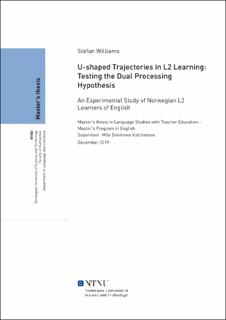| dc.description.abstract | This study explores U-shaped behaviour in the acquisition of irregular verb morphology across three different groups of Norwegian L2 learners of English. This phenomenon is of special interest due to its significance for the organization and division between the mental lexicon and grammar. A cross-sectional design with randomly recruited students from three different grades was employed. The final analysis includes data from participants within the 8th grade (N=17), 9th grade (N=19), and 10th grade (N=15). We report results on the acquisition of irregular verb and noun morphology, in addition to mean reaction times on different types of responses (accurate responses and overregularized ones). The students were given elicitation tasks based on Berko’s (1958) Wug-test to mainly test irregular past tense verbs via the use of an online survey-platform. We hypothesized that if a U-shaped trajectory could be observed across the three groups, then we would find significant differences between the three groups in accuracy levels in conjunction with overregularization errors. Our results model the later stages of U-shaped learning where we found an increase in overall accuracy co-occurring with a decrease in overregularization errors. We propose that the existence of U-shaped behaviour in the L2 suggests universality as opposed to simply L1 transfer, and that this learning process is an integral part of acquiring and establishing knowledge in the mental lexicon related to regular and irregular morphology. Finally, we theorize how U-shaped behaviour speaks in favour of a dual-organization of the mental faculty as opposed to a connectionist account. | |
